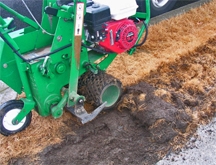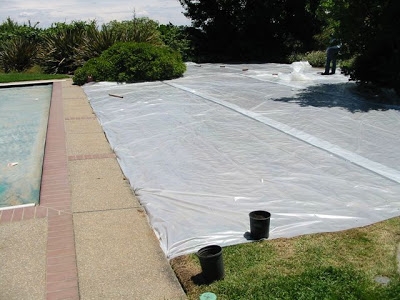Client's Request to MGCC's Help Desk: Hopefully the Water District will soon approve my plans to replace the back yard lawn with a Zen rock garden utilizing black and white gravel. I have two small dogs so I don't want to use chemicals to kill the grass. Do you have suggestions to kill the grass that are pet friendly? I went to the rock supply business and they advised me to put some black material over the dirt to prevent weeds/grass from sprouting up. Should I dig up the grass or is there another way?
Advice From the MGCC's Help Desk: The current drought situation has motivated people such as yourself to replace their lawns with alternatives that use less water. Your idea of a Zen rock garden sounds like a wonderful option. There are several ways to remove lawn grass. The one you choose will depend on how large your lawn is, how much manual labor you want to invest, how much you want to spend, and how big of a hurry you are in.
Herbicide
Although you said that you have two small dogs and don't want to use chemicals to kill the grass, after considering the available options, you may want to reconsider ... of course following all required instructions and precautions. There are a number of herbicides that will kill lawn grass, but most are not substances that Master Gardeners would endorse using as your primary solution as they often leave residuals that carry too much risk of eventually ending up in runoff and/or problems with adjacent plants. Some herbicides, such as glyphosate (the active ingredient in widely available Roundup™), leave much less residual, but overspray can also damage adjacent vegetation. According to the manufacturer's label, Roundup is safe for pets and children to walk on after it has dried completely. However, you may not want your pets eating plants treated with glyphosate. According to the National Pesticide Information Center, pets that come in contact with wet glyphosate products may drool, have stomach upset, lose their appetite, or become sleepy. If you were to decide to use glyphosate, you should follow the manufacturer's instructions carefully.
Physical Removal
Removing sod doesn't work if you have a persistent perennial lawn grass like Bermuda grass – however it will work with Blue, Rye, and Fescue grasses. Simply removing the sod on Bermuda guarantees that it will be back, since the roots go down for several feet, and it only takes an inch of root to grow it all back. In this case, the only way to get rid of the lawn is through solarization or herbicides — plus several months of waiting to be sure it's really gone.
Solarization
using clear plastic
Weed Block Fabric
Because you mentioned that you had applied to the Water District for a rebate, you will need to use a biodegradable weed block fabric because your Water District considers “non-biodegradable weed-block material” as a non-qualifying rebateable material. Your hardware or home center should be able to provide you with the specifications of their weed block material so that you can confirm that it is biodegradable.
For even more information on lawn removal see the U.C. website http://www.ipm.ucdavis.edu/TOOLS/TURF/RENOVATE/comremtrf.html.
Please feel free to contact us if you need more information.
Good luck on your lawn removal and Zen garden project.
Master Gardeners of Contra Costa Help Desk
Note: The Master Gardeners of Contra Costa's Help Desk is available year-round to answer your gardening questions. Except for a few holidays, we're open every week, Monday through Thursday for walk-ins from 9:00 am to Noon at 75 Santa Barbara Road, 2d Floor, Pleasant Hill, CA 94523. We can also be reached via telephone: (925) 646-6586, email: ccmg@ucanr.edu, or on the web at http://ccmg.ucanr.edu/Ask_Us/